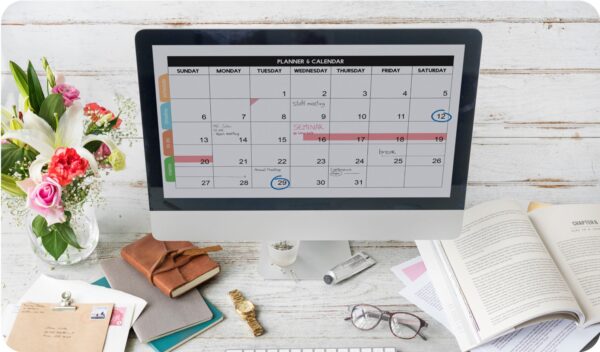How to Create a Content Schedule for Your Blog (and Stick to It)
Starting a new blog feels like stepping onto a blank slate. The excitement, the ideas buzzing in your mind, and the possibilities seem endless. But that blank slate can soon become overwhelming, especially when you’re unsure what to write, when to publish, or how to keep up the momentum. That’s where having a content schedule comes in.
Having a blog content schedule isn’t just about being organized (though that’s a big plus); it’s about sustainably nurturing your passion for blogging. Whether you’re a new blogger trying to figure it all out or an experienced creator seeking to hit refresh, this guide will walk you through building a blogging schedule that works for YOU.
Why Does a Content Schedule Matter?
Think of a content schedule as your blog’s game plan. Without a plan, you’re playing a reactive role instead of a proactive one, and that’s a recipe for stress and inconsistency. A content schedule:
- Keeps you consistent (hello, loyal readers!)
- It reduces overwhelm by giving you clarity on what’s next. No more last-minute scrambles, looking at a blinking cursor late at night, trying to meet tomorrow’s deadline.
- Target the right audience with strategic, well-timed content.
- Room for experimentation and creativity. Go beyond boring and mix things up!
When I first started blogging, I thought “winging it” was the way to go. I’d wait for inspiration to hit (spoiler alert: it doesn’t always). It wasn’t until I attempted my first content schedule that I realized how much mental energy I wasted trying to figure out my next move. Does this sound familiar? If so, keep reading.
Step 1: Understand Your Audience
Before you start scheduling posts, you need to know who you’re writing for. Ask yourself:
- What niche are you passionate about?
- Who is your ideal reader? Be as specific as possible. Consider creating an avatar.
For example, if your blog focuses on sustainable fashion, your audience might be individuals seeking to minimize their environmental impact without compromising their style. Understanding your audience’s specific pain points, interests, and goals is crucial as it guides you in brainstorming topics and keeping your content focused on what truly matters to them.
When I niched down and started writing for beginner bloggers instead of “anyone interested in writing,” two magical things happened:
- My posts began resonating with the right readers.
- I felt genuinely excited to create content that served their needs.
Step 2: Best Practices for Scheduling Blog Posts
How often should you post? What’s the “perfect” time to publish?
Here’s the secret sauce:
- Start Small: New bloggers often burn out because they aim too high too quickly. Starting with one post per week and building up as you grow more comfortable is a great way to ease into the process and feel encouraged rather than intimidated. I made the mistake of trying to write 50 articles before I launched my first blog. It was exhausting, and I quickly started to question why I was doing this. Then, I got realistic when launching my third blog; I started with six articles, one for each category. Wow, what a difference! I couldn’t wait to sit down and write the next article, rather than dreading my content days.
- Choose Your Day: Analyze your audience. Are they more active on weekends, weeknights, or mornings? Much of this can also depend on your niche, whether your brand is focused on B2B or B2C. What does your average week look like? What days are you dedicated to writing, prior to blog posting days?
- Batch Your Tasks: Batching tasks involves dedicating specific days to each stage, such as brainstorming, writing, editing, and promoting. This approach helps you manage your time and resources more efficiently. You can focus on one aspect of content creation at a time rather than feeling scattered and overwhelmed by trying to do everything at once. There are days when I love the visual creative side and days when I’m ready to dive all in on writing. It truly is a balancing act, dedicating time to specific tasks, which has helped me stay on track.
- Leave Flex Room: Life happens. Yes, you are not alone. Things pop up in your week that may not have been planned. Your content schedule should be a guide, not a straitjacket. Stay flexible!
Pro-tip for beginners: Tuesdays through Thursdays are generally great days for publishing. Watch your analytics and adjust as needed in the future.
Step 3: Quality Over Quantity (Always)
Want to know how long your blog posts should be? Anything between 1,000 and 2,500 words performs well for SEO. But truthfully, no one’s coming to your blog thinking, “I hope this post is 2,000 words long.” People want clarity, engagement, and solutions to their problems.
Don’t fall into the “word count trap.” Instead:
- Focus on delivering value in every single post.
- Write with a conversational, relatable tone.
- Add visuals, bullet points, and headers to keep readers engaged.
Remember, you’re building a connection, not just filling a page.
Step 4: Brainstorming Topics That Wow
Feeling stuck on what to write about? Here’s an easy brainstorming guide:
- Mind Map: Write the main category of your blog in the center of a page and branch out into subtopics.
- Audience Questions: What are the common questions or challenges your readers face? Answering these makes for excellent topics. Refer to forums for questions being asked by your target audience.
- Competitor Inspiration: Study your competitors, but don’t copy them. Identify gaps in their content and provide your unique take. Don’t be afraid to share your perspective and experiences.
- Trends and Tools: Tools like BuzzSumo, Google Trends, or AnswerThePublic, which has over 2.7M users, can help you spot relevant trends in your niche.
Keeping a digital “ideas notebook” (shoutout to Trello!) inspires me. Capture ideas as they come, even if they seem random at first. Some of my best-performing posts came from seemingly unremarkable sparks of inspiration!
Step 5: Create Your Own Content Calendar
A content calendar can help you stay on task, organize your ideas, meet deadlines, and support promotional efforts. Here’s how to create one:
Tools:
- Google Calendar or Notion for simplicity and collaboration.
- Trello or Monday.com if you like a visual, Kanban-style approach.
- Templates from Canva for printable options.
What to Include:
- Post title ideas
- Target publication date
- Keywords for SEO
- Call-to-action (CTA, like subscribing or downloading a freebie)
- Promotion strategy (email, Pinterest, etc.)
Consistency is key, but don’t stress about filling your calendar perfectly. A few high-quality, well-thought-out posts are far better than a dozen rushed ones.
Step 6: Promoting Your Content
Here’s the thing about blogging that trips up many new creators: writing is only half the battle. The real magic happens when you share your posts strategically. But don’t panic; there’s more to promotion than just social media (we’ll still include it).
Ways to Promote Beyond Social Media
- Email Newsletter: Readers are already engaged with your content; help promote engagement and provide additional value through your newsletter.
- Repurpose Content: Turn blog posts into Pinterest pins, Instagram captions, Twitter threads, or podcasts. One blog post can stretch FAR.
- Blog Communities: Join forums or groups (e.g., Medium, subreddits) where your ideal audience might hang out.
- Guest Posting & Collaborations: Write guest posts for established bloggers or collaborate with others in your niche to expand your reach.
Step 7: Analyze Your Progress and Adjust
What gets measured gets done! Pay attention to your blog’s performance data to refine your strategy. Tools like Google Analytics and Yoast SEO can help you:
- Track which topics perform well.
- Understand your visitors’ behavior, such as bounce rate and time spent on posts.
- Optimize your headlines, structure, and SEO based on what works.
Celebrating small milestones, such as your first few comments, is crucial. Take it from me: Building a successful blog takes time, energy, and patience. It is like training for a marathon, not a sprint—think beyond today or next week and plan for the future. Progress might feel slow at first, but every small win matters and will help give you the motivation to keep going if you stay engaged.
How Long Does It Take to Build a Successful Blog?
The short answer? It depends. Bloggers with a strategic plan and consistency often start seeing growth within six months to a year. However, “success” is defined differently for everyone. Always remember WHY you started blogging in the first place. Focus on building an engaging, supportive community rather than obsessing over traffic numbers. I know this can be a challenge; however, if you’re looking to make blogging your full-time gig, this is an important step.
Final Thoughts on Building a Content Schedule
Crafting a blog content schedule is less about rigid timelines and more about empowering yourself as a creator. It’s about showing up consistently, experimenting with new ideas, and finding joy in the process. Don’t forget to take care of yourself along the way. Burnout isn’t conducive to great content!
And remember, blogging is a team sport. Surround yourself with other bloggers, share ideas, and engage with your readers like friends. Who knows? It might be the start of something incredible.
Want more tips, tricks, and resources for your blogging business? Subscribe to our newsletter and never miss a post. Your best blogging days are ahead!



